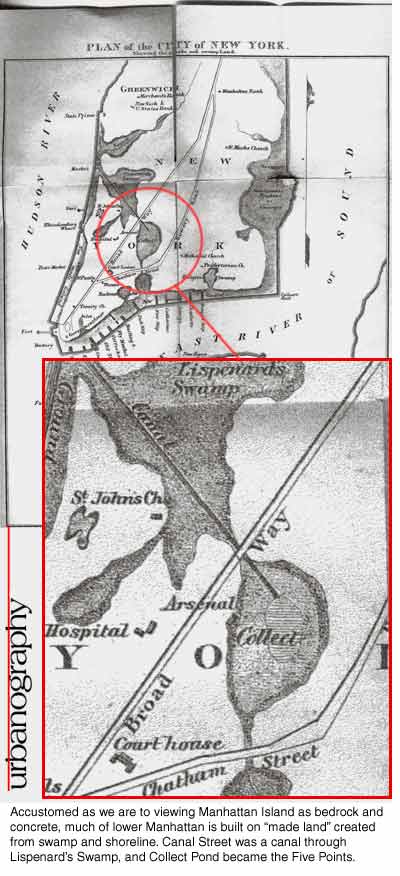
Page 4
CAUTION TO BOARDING HOUSE KEEPERS
– A tall, red faced Mason, who works on the building in
the Bowery, nearly opposite Spring street and boards in Grand
street, named Gustav Johnson, left my house with his board
unpaid. He is a Virginian but says his is from Baltimore.
J. A. JONES, 196
Bowery. J24 – 3t*
_________________________
$5 REWARD – LOST –
Near Washington Market, a Wallet containing between thirty
and forty dollars on different banks.
One ten and a five on the Catskill bank – one five
on the Girard Bank of Philadelphia, and fifteen or twenty
dollars on broken banks, and papers of no value except to the
owner. The above reward will be given to any person that
will return said Wallet to the Clerk of Washington market.
J23 – 2t*
 | ||
_________________________
Our fathers find their graves in our
short memories, and sadly tell us how we may be buried in our
survivors. Oblivion is not to be hired. The greater
part must be content to be as though they had not been –
to be found in the register of God, not in the record of man.
[Sir Thomas Browne.
_________________________
MERCHANTS, MECHANICS, LANDHOLDERS, and
all others, are hereby duly authorized to call and see my Stave
Machine, “gratis;” and a greater curiosity is
seldom seen. It takes in any kind of timber, and shelfs
out first rate staves, suitable for any kind of casks so
perfectly, that the hogshead, barrel, or keg made from them not
only looks better than any others, but in fact is so in every
way. I can manufacture in the most perfect style, from
any kind of timber, from 200 to 400 staves per hour. It
does seem to me (as well as many of our first businessmen, if I
may judge from the manner in which they have patronized me)
that a small capital cannot be laid out to better advantage.
I have it in operation for half an hour every day at the
Machine shop of Robert Hoe & Co. No. 31 Gold street,
a little north of Maiden lane, commencing precisely at 12
o’clock.
JAMES LUCKEY. A6-tf
_________________________
From the New
York Tribune, November 1, 1849.
The Cholera in New York in 1849.
We have finally the Report of the
Sanatory Committee of the Board of Health in relation to the
Cholera as it prevailed in this City during the past Summer.
The Committee in opening their Report,
observe that its issue has been considered essential not only
as a record for future reference, but as Justification of some
of the measures which they have felt themselves obliged to take
in opposition to the
remonstrances of many of their most
respected valued fellow-citizens.
 | ||
The Sanatory Committee were appointed
by the Board of Health on the 16th of May last, and invested
with the full powers of the Board. Their first business
was to associate with them sundry Medical Counsel. The
first case of Cholera was announced on the 14th of May, at the
“Five Points” where several succeeding cased
occurred. The condition of that den of filth and iniquity
at this time was quite sufficient to breed any epidemic of the
most virulent character – much more to imbibe the seeds
of infection when once prevalent in the atmosphere. To
separate the sick from this lazar-house (sic) was then of
course the primary concern. For this purpose,
accordingly, a small two-story building at 127 Anthony st. was
occupied as a temporary Hospital, and Dr. W. P. Buel appointed
the Attending Physician. To this place seven patients
were conveyed – and the question of Hospital
accommodations generally immediately came up.
* * *
* * * *
*
The Committee having arrived at their
conclusions, the large three-story building known as
“Monroe Hall” at the corner of Pearl and Centre sts
was obtained and occupied on the 18th of May. This
building was in the neighborhood of the Five Points, but
contained the advantages of air and elevation. The two
upper stories consisting of large halls were well calculated
for the wards of the Hospital. The building has since
been known as the “Centre st Hospital.” Here,
all patients were immediately transferred from the temporary
house in Anthony st. and the whole placed under the care of Dr.
Buel.
On the 21st of May, the Sanatory
Committee, in company with the Mayor and others, made a
personal visit to the Five Points, and made no concealment of
the truth. Hence their report of it was bad enough.
The place itself is incapable of proper purification, and
will continue to remain so until it is razed to the ground,
filled up and suitably rebuilt.
General measures were now at once
acted upon to meet the impending danger. And in doing
this, the Committee found several important facts which
appeared to be well established, and which served as guides in
their future course. These were:
1st. That the general cause of
the disease appears to exist in the atmosphere.
2nd. That in attacking
individuals the disease generally gives notice of its approach
by some preliminary symptoms.
3d. That these symptoms are
ordinarily under the control of medicine, and, being arrested,
the further development of the disease is checked.
4th. That the agency of various
existing causes is generally necessary to develop the malady.
Among those, the principal are the existence of filth and
imperfect ventilation, irregularities and imprudences in the
mode of living, and mental disturbance.
With these facts and the purposes in
view which were thence suggested, the Committee commenced
and continued their labors throughout the whole course of
the Cholera. They established Hospitals in such
succession and in such parts of the City as the spread of the
disease required, until the whole number amounted to FIVE.
* * *
* * * *
*
From the New
York Tribune, June 5, 1850.
We now come to the Sixth Ward –
the “Five Points” – the St. Giles, the Cite,
of New York – the scene of more monstrous stories (at a
distance) than any other spot in America and yet is not such an
awful place, after all, except in great number of its low
houses of ill-fame; there is a far dirtier ward up town, and as
for its inequities, it has some fast growing competitors.
The Sixth Ward return shows 285 basements, 498 rooms, and
4,156 occupants – or less than 2 ½ in a room
population, 19,343 – residents in cellars being 1 in 17.
At 8 Mulberry st. are 10 in 1 room; (this place, 9 and 10
Mulberry, two large five story houses, contains sixty-nine
families and three-hundred and fifty-seven persons;) 163
Anthony, rear, 9 in a room; 56 Centre, 20 in 5 rooms; a few
instances of 5 in a room – but very rare, as may be seen
by the aggregate. The dirtiest part of the Sixth may be
found in Elm from Pearl to Anthony, Centre from Pearl to
Franklin, Cross from Centre to Mulberry, pearl from Cross to
City Hall-place, Anthony from Broadway Theater to Orange,
Leonard from Elm to Orange, from Chatham to Walker, and Bayard
from Orange to Mulberry. Of all the Wards which may be
characterized as dirty, the Sixth is the least crowded with
cellar population. The population is probably two-thirds
of foreign birth or children of foreigners, with a full
sprinkling of blacks.
* * *
* * * *